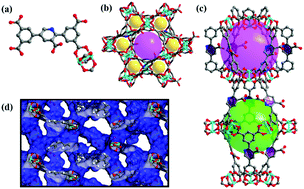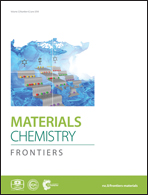Enhancing light hydrocarbon storage and separation through introducing Lewis basic nitrogen sites within a carboxylate-decorated copper–organic framework†
Abstract
A novel nanoporous Cu metal–organic framework (NEM-4) with open CuII sites, Lewis basic nitrogen sites, and uncoordinated –COO− groups exhibits both outstanding uptake capacities (in cm3 (STP) g−1) for C2H2 (204), C2H4 (164.1), C2H6 (172.2), C3H6 (197.4), and C3H8 (196.1) and high selectivities for C2H2/CH4 (63.2), C3H6/CH4 (174.8), and C3H8/CH4 (168.3) under ambient conditions. After eight cycles of adsorption–desorption tests, only 8.2% and 10.3% decrease in the acetylene and propene storage capacities was observed, indicating an excellent repeatability. Compared with 1 (carboxylate decorated NOTT-101), when nitrogen sites are inserted, the C2–C3 hydrocarbon uptakes of NEM-4 can be significantly enhanced. Grand Canonical Monte Carlo and first-principles calculations reveal that not only the open CuII sites but also the uncoordinated –COO− groups and the nitrogen sites play significant roles in its high C2–C3 hydrocarbon uptakes. Moreover, the adsorption and separation of cationic dyes in NEM-4 are highly size and charge state dependent, and the adsorbed methylene blue (MB+) in NEM-4 can be efficiently released in an NaCl-containing CH3OH solution. This study reveals that the combination of open metal sites, carboxylate groups, Lewis basic pyridyl sites, and appropriate pore geometry is responsible for the high adsorption/separation of light hydrocarbons in NEM-4.



 Please wait while we load your content...
Please wait while we load your content...